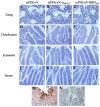Characterization of the Cross-Species Transmission Potential for Porcine Deltacoronaviruses Expressing Sparrow Coronavirus Spike Protein in Commercial Poultry
- PMID: 35746696
- PMCID: PMC9230012
- DOI: 10.3390/v14061225
Characterization of the Cross-Species Transmission Potential for Porcine Deltacoronaviruses Expressing Sparrow Coronavirus Spike Protein in Commercial Poultry
Abstract
Avian species often serve as transmission vectors and sources of recombination for viral infections due to their ability to travel vast distances and their gregarious behaviors. Recently a novel deltacoronavirus (DCoV) was identified in sparrows. Sparrow deltacoronavirus (SpDCoV), coupled with close contact between sparrows and swine carrying porcine deltacoronavirus (PDCoV) may facilitate recombination of DCoVs resulting in novel CoV variants. We hypothesized that the spike (S) protein or receptor-binding domain (RBD) from sparrow coronaviruses (SpCoVs) may enhance infection in poultry. We used recombinant chimeric viruses, which express S protein or the RBD of SpCoV (icPDCoV-SHKU17, and icPDCoV-RBDISU) on the genomic backbone of an infectious clone of PDCoV (icPDCoV). Chimeric viruses were utilized to infect chicken derived DF-1 cells, turkey poults, and embryonated chicken eggs (ECEs) to examine permissiveness, viral replication kinetics, pathogenesis and pathology. We demonstrated that DF-1 cells in addition to the positive control LLC-PK1 cells are susceptible to SpCoV spike- and RBD- recombinant chimeric virus infections. However, the replication of chimeric viruses in DF-1 cells, but not LLC-PK1 cells, was inefficient. Inoculated 8-day-old turkey poults appeared resistant to icPDCoV-, icPDCoV-SHKU17- and icPDCoV-RBDISU virus infections. In 5-day-old ECEs, significant mortality was observed in PDCoV inoculated eggs with less in the spike chimeras, while in 11-day-old ECEs there was no evidence of viral replication, suggesting that PDCoV is better adapted to cross species infection and differentiated ECE cells are not susceptible to PDCoV infection. Collectively, we demonstrate that the SpCoV chimeric viruses are not more infectious in turkeys, nor ECEs than wild type PDCoV. Therefore, understanding the cell and host factors that contribute to resistance to PDCoV and avian-swine chimeric virus infections may aid in the design of novel antiviral therapies against DCoVs.
Keywords: S protein; chicken embryos; coronaviruses; cross-species infection; porcine delta coronavirus; sparrow delta coronavirus; turkey poults.
Conflict of interest statement
The authors declare no conflict of interest.
Figures










Similar articles
-
Chimeric Porcine Deltacoronaviruses with Sparrow Coronavirus Spike Protein or the Receptor-Binding Domain Infect Pigs but Lose Virulence and Intestinal Tropism.Viruses. 2021 Jan 17;13(1):122. doi: 10.3390/v13010122. Viruses. 2021. PMID: 33477379 Free PMC article.
-
Chicken or Porcine Aminopeptidase N Mediates Cellular Entry of Pseudoviruses Carrying Spike Glycoprotein from the Avian Deltacoronaviruses HKU11, HKU13, and HKU17.J Virol. 2023 Feb 28;97(2):e0194722. doi: 10.1128/jvi.01947-22. Epub 2023 Jan 19. J Virol. 2023. PMID: 36656013 Free PMC article.
-
Porcine Deltacoronavirus Infection and Transmission in Poultry, United States1.Emerg Infect Dis. 2020 Feb;26(2):255-265. doi: 10.3201/eid2602.190346. Emerg Infect Dis. 2020. PMID: 31961296 Free PMC article.
-
Epidemiology, pathogenesis, immune evasion mechanism and vaccine development of porcine Deltacoronavirus.Funct Integr Genomics. 2024 Apr 24;24(3):79. doi: 10.1007/s10142-024-01346-7. Funct Integr Genomics. 2024. PMID: 38653845 Review.
-
Porcine deltacoronavirus infection: Etiology, cell culture for virus isolation and propagation, molecular epidemiology and pathogenesis.Virus Res. 2016 Dec 2;226:50-59. doi: 10.1016/j.virusres.2016.04.009. Epub 2016 Apr 13. Virus Res. 2016. PMID: 27086031 Free PMC article. Review.
Cited by
-
Cross-species transmission, evolution and zoonotic potential of coronaviruses.Front Cell Infect Microbiol. 2023 Jan 6;12:1081370. doi: 10.3389/fcimb.2022.1081370. eCollection 2022. Front Cell Infect Microbiol. 2023. PMID: 36683695 Free PMC article. Review.
-
Isolation, phylogenetics, and characterization of a new PDCoV strain that affects cellular gene expression in human cells.Front Microbiol. 2025 Mar 26;16:1534907. doi: 10.3389/fmicb.2025.1534907. eCollection 2025. Front Microbiol. 2025. PMID: 40207165 Free PMC article.
-
Porcine Deltacoronaviruses: Origin, Evolution, Cross-Species Transmission and Zoonotic Potential.Pathogens. 2022 Jan 9;11(1):79. doi: 10.3390/pathogens11010079. Pathogens. 2022. PMID: 35056027 Free PMC article. Review.
-
Abortive PDCoV infection triggers Wnt/β-catenin pathway activation, enhancing intestinal stem cell self-renewal and promoting chicken resistance.J Virol. 2025 Apr 15;99(4):e0013725. doi: 10.1128/jvi.00137-25. Epub 2025 Mar 26. J Virol. 2025. PMID: 40135895 Free PMC article.
-
Transcriptomic Analysis of PDCoV-Infected HIEC-6 Cells and Enrichment Pathways PI3K-Akt and P38 MAPK.Viruses. 2024 Apr 9;16(4):579. doi: 10.3390/v16040579. Viruses. 2024. PMID: 38675921 Free PMC article.
References
-
- Masters P.S., Perlman S. In: Fields Virology. Knipe D.M., Howley P.M., editors. Vol. 2. Lippincott Williams & Wilkins; Philadelphia, PA, USA: 2013. pp. 825–858.
Publication types
MeSH terms
Substances
Supplementary concepts
LinkOut - more resources
Full Text Sources
Miscellaneous

